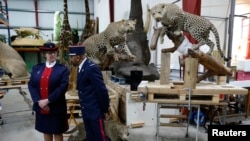"We are very much concerned," Swart, a zebra skull sitting on his desk, tells AFP. "The law could create a domino effect."
Trophy hunting contributes more than $340 million a year to South Africa's economy supporting some 17,000 jobs, according to a 2018 study.
Hunters often bring home parts of the animals as trophies.
These are processed by taxidermy firms that employ about 6,000 people in South Africa, according to Swart, leader of trade group South African Taxidermy and Tannery Association.
The British legislation, which aims to help protect endangered animals, was approved by U.K. lawmakers in March.
Covering thousands of species, including lions, rhino and elephants, it reflects a broader shift in western societal views on hunting against a backdrop of declining global wildlife numbers, according to animal rights groups.
"This is very much the start of a change in attitudes amongst (European) countries," says Matthew Schurch, wildlife expert with animal welfare group Humane Society International.
Similar bills are being considered in such countries as Italy, Belgium and Spain, according to HSI.
The law is backed by numerous celebrities including model Kate Moss and football presenter Gary Lineker, but African conservationists and those in the hunting business say it is misguided.
Trophy hunting - where hunters pay thousands of dollars for the right to kill usually big game animals like elephants and lions - has long been controversial.
Proponents contend that the killing of a small number of selected, usually old animals generates much needed income for conservation and anti-poaching efforts and support local communities.
As the controversy rages on, piles of skins, skulls, horns and bones lay in Swart's workshop, waiting to be turned into rugs and ornaments.
Thousands of carcasses are processed at the Rayton facility, near Pretoria, every year.
Most come from culling done by game reserves, while a smaller part is brought in by international hunters, says Swart.
"Hunting and culling are one of the processes of managing the animals. And to waste a skin like this...and to just let it degrade is not cost effective," Swart, sporting a grey goatee, says pointing to a zebra bust hanging on the wall.
A full mount taxidermy of a rhino costs more than 130,000 rand ($6,800), while a cheetah goes for $1,360
"If they are going to ban this job,... I am not going to manage to feed my family," says Elias Pedzisai, 45, who works his "magic" bleaching skulls at Swart's Afrikan Tanning & Taxidermy firm.
Critics say shooting wild animals for fun is cruel, wasteful and pushes endangered species closer to extinction.
For South Africa's National Council of Societies for the Prevention of Cruelty to Animals, hunting an animal for it to be mounted on your wall is "questionable,"
"There are far more ethical and humane ways of generating income," said spokeswoman Keshvi Nair.
While Britons make up a small share of trophy hunters in South Africa, the law - which is being scrutinized by the upper house of parliament - is already causing damage, says Swart.
If more countries were to follow "we will see a considerable part of our market come to a grinding halt," says Douglas Cockcroft, director of Splitting Image Taxidermy, another company employing more than 100 people.
The prospect already has South African taxidermists pursuing new opportunities.
"There have been inroads into the Chinese and Russian markets," Swart says.
"Hunters from those countries that in the past didn't come here now are coming to South Africa on a more regular basis."









